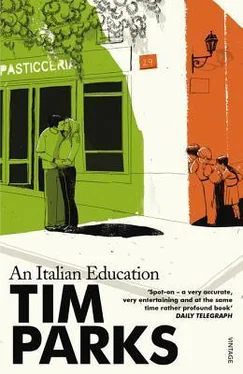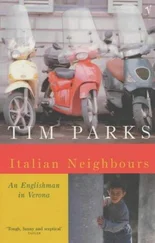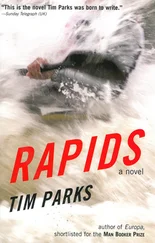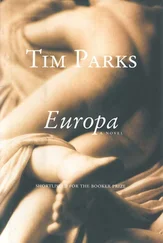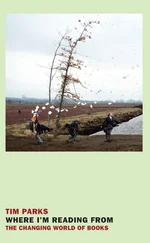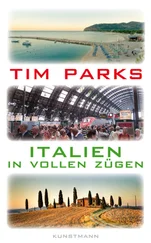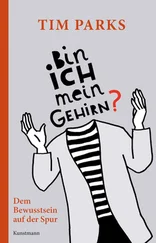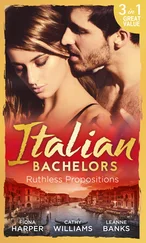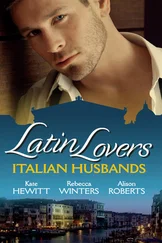The cars weave back and forth across the piazza. It’s hectic. Mainly mothers at the wheel. Or grandmothers. They are wondering if the tennis racket they have bought is expensive enough, if Giovanni will make the team, if Chiara has the right physique for it, pampering and tormenting this new generation of Italians with their own vision of what the good life might be.
The fake church bells chime. The twee sound spreads across the village like runny treacle. È l’ora che pia … It drowns out Ilaria showing the kids how to lift one skate and pirouette, distracts the football trainer explaining the Hungarian’s method of springing the offside trap, irritates the BMX instructor teaching the kids how to start from a grid. The mothers wait in their cars. How much time will the children have to eat their dinners and be dressed come si deve for catechism?
Walking back up the path from the gate on a Wednesday night in winter I am carrying Stefi’s dance bag, two pairs of skates, and the plastic case with the music books in it. Everything seems to happen on Wednesday. I spend two hours shuttling everybody around. I climb the path. And there, wrapped in his coat, sitting beside one of our ridiculous garden lights, is Hristo, our refugee. He has come out to smoke a cigarette, because someone has objected to the smell of cigarettes from the cellar invading the stairwell. The children stop to talk to him. His Italian is much better now. Shivering, he grins. And sometimes he kicks a ball around with the children on the cement behind the garage. Michele likes playing football with Hristo and the other boys in the condominium on the cement behind the garage. Silvio joins in. And me. Hristo plays with a cigarette in his mouth, which is definitely not come si deve , though he certainly knows how to play.
‘How many times can you kick the ball up in the air without it touching the ground?’ Michele asks. Hristo shows, hopping about on Righetti’s rough cement after a day’s whitewashing, ash falling from his cigarette. Twenty-five! Silvio is even better. I only manage seventeen. Sometimes it seems one doesn’t need teachers to get a little exercise…
Though how, Silvio wants to know, climbing the stairs, is Hristo heating himself down there in the cellar, with all that flammable paint around him? And how, even if we pursue the legal line (the lawyers have exchanged letters), can we chuck him out on the street? Generously, he invites the Slav up to watch television with him in the evenings, to hear the news, which inevitably spends an inordinate amount of time presenting the achievements of the nation’s football team, or basketball team, or volleyball team (world champions), or water polo team (world champions), or their athletes, or their tennis players, or even, recently, their rugby team. ‘ Miracolo! ’ the announcer claims, borrowing a word from another strong suit in Italian traditions. Miracolo di Pescosolido — the tennis player has beaten Edberg. Miracolo della Ferrari — they have won their first race in years. Miracolo di Benvenuti — he has won the eight hundred metres at the European games. Che spettacolo! And you know it’s not a miracle at all. It’s the result of all the sacrifici that parents made ferrying their kids back and forth from one activity to another, doing things come si deve .
Along with his penknife, catapult and sharp stick, scourge of all vipers, another thing Michele now carries around with him on his walks is his wallet. Because the children get pocket money now. Five thousand lire a week. But Stefi doesn’t carry around her pocket money because she spends it all at once. Or allows Michele to ‘save it for her’. A very dubious procedure. However, even if he always and unfailingly carries it round with him all the time, money is quite safe with Michele. He will never forget it because it is never far from his mind. He likes to gloat over it. He likes to count it, blue-eyed and eager. His endless questions have found a new focus.
‘How many lire in a miliardo , Papà?’
‘ Un miliardo , of course.’
‘But how much is that?’
‘A thousand million.’
More innocent still, Stefi asks, ‘And how much is a million?’
‘A thousand thousand.’
‘So I need a thousand of these,’ Michele holds up an extremely battered note, ‘to make a million.’
‘Right.’
‘ Cavolo! ’ Stefi says. Cabbage! Which is to say, Wow!
‘But how many zeros in a miliardo ?’ Michele persists, now counting the noughts on his ten-thousand-lire note.
‘Nine.’ It’s important to have children get used to these big numbers. It’s important to get used to them yourself.
‘And a miliardo di miliardi ?’ he asks.
I laugh: ‘That would be the national debt, or thereabouts.’ That number beyond which there are no others.
‘The what?’ He’s puzzled, of course. Shall I tell him that every Italian man, woman and child owes something like thirty million lire, more than his pocket money can ever amount to? There seems no point in going into the matter too deeply just at the moment. After all, the government never has, and if they did…
Michele has a pound coin in his wallet, too, that he keeps from last holiday in Somerset.
‘How many lire is it worth, Papà?’
‘Today, you mean?’ I explain the concept of exchange rates. Would that I hadn’t.
‘Two thousand and fifty lire.’
‘And today?’
‘Two thousand one hundred lire.’
‘And today?’
‘Two thousand three hundred lire.’
‘And today?’
‘Two thousand four hundred and fifty lire.’
‘And…’
Thank God the kid doesn’t have a deutschmark. Otherwise, we might have a thoroughgoing neurotic on our hands. I’m jealously guarding the secret that his savings are losing value every day, the way I’ve tried for so long to hide the fact that it is us and not Santa Lucia who bring them their presents just before Christmas.
Sitting together in their jackets on the blue-green grass of a hilltop for a November picnic, the children lay out all their money on a stone and stare at it, something that, like the picnic, would be impossible in a windier country. For it’s a currency made up almost entirely of notes, light as air. The biggest coin amounts to no more than twenty pence.
And it’s a colourful currency, too, as packaging here is very colourful, and religious images. The thousand-lire notes are grey or pink, the two thousand-lire notes are orange and brown, the ten thousand-lire notes are a lovely blue, the fifty thousands are pink again, but softer and bigger than the one thousand, and the hundred-thousand lire note is an impressive spettacolo of pastel browns and greens with hints of blue. Unlike the dull, utilitarian dollar, such a currency does lend a certain enchantment to the business of spending.
Stefi loves the pictures on the notes, the horses, the bowls of fruit, ships, children studying. And the faces that go with them. Whose faces? I have to explain who Giuseppe Verdi was, and Bellini. That’s why the picture is an opera house. You see, La Scala. I promise Stefi we’ll go to see L’Aida in the Arena when she’s bigger, though not, I don’t think, I puritani . I explain that Maria Montessori, on the one-thousand note, invented a new method for teaching children, yes, which they use in their scuola elementare to a certain extent, when they give them all those projects to do where you’re supposed to learn on your own rather than be told things. And then they tell you what you’re supposed to have learnt. Michele already knows everything about Guglielmo Marconi on the two-thousand note, about his radio call to America, though not that the scientist became a fascist in later life and was happy, it seems, to see his name in school-books as the inventor of something that helped conquer the vast Abyssinian army. But we can spare the boy that. On the ten-thousand note there’s Count Alessandro Giuseppe Antonio Anastasio Volta. ‘Think if you had to use his whole name!’ Stefi says, when I explain (approximately) what he discovered.
Читать дальше
